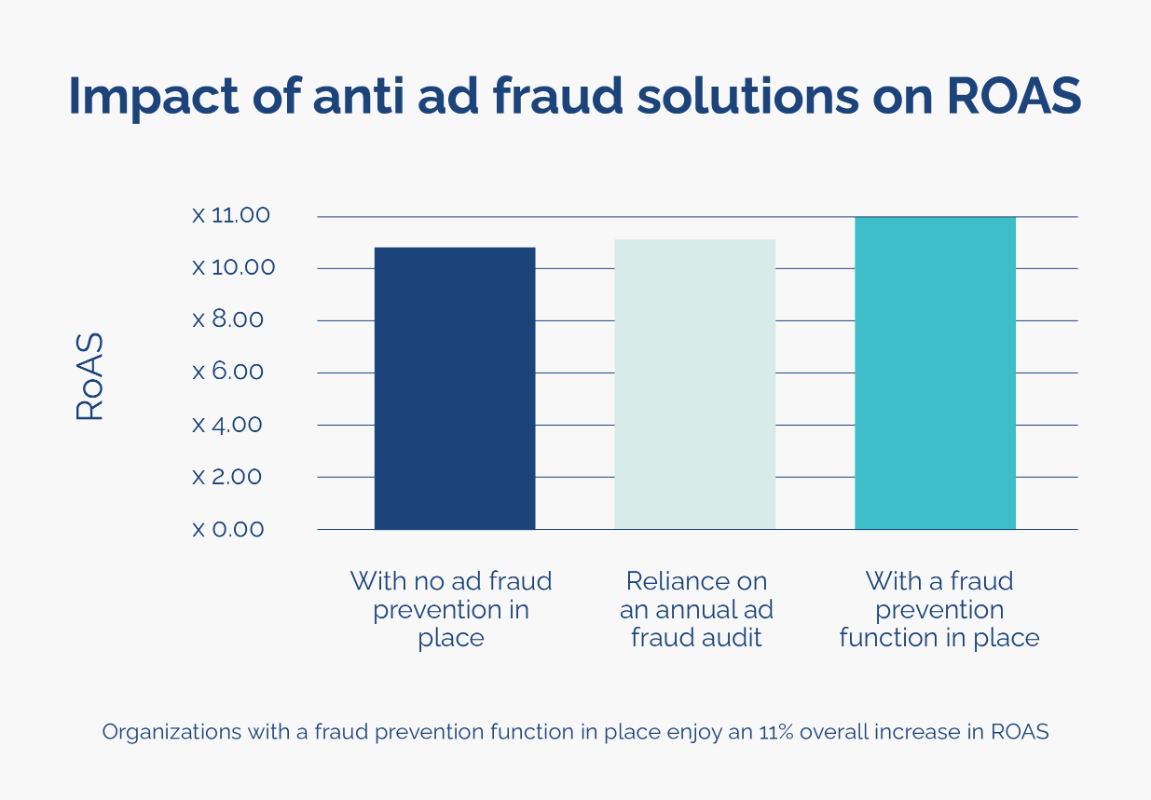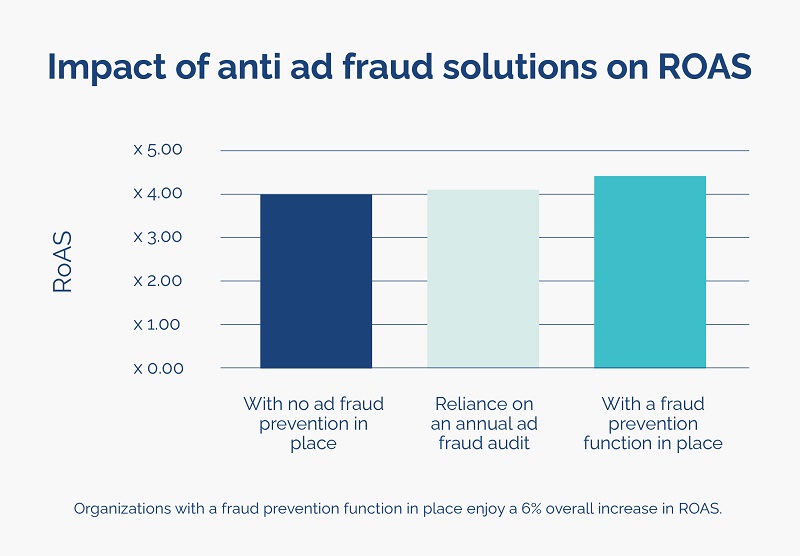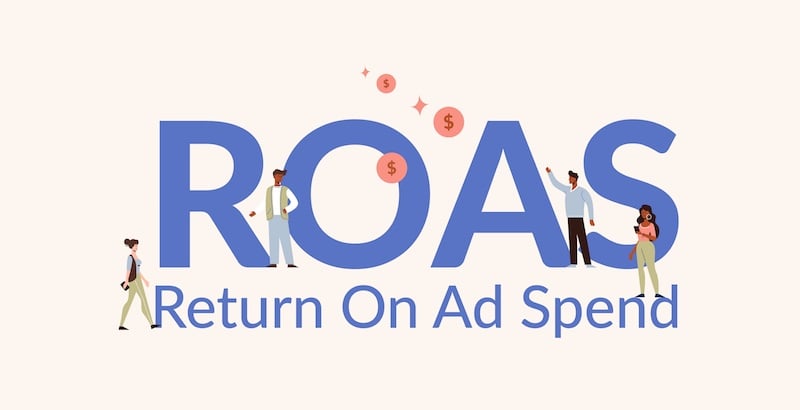ROAS is a crucial metric for helping marketers understand and measure the effectiveness of their ad campaigns. It’s also a great way to benchmark and optimize ads with A/B testing and other strategies. But what is ROAS exactly? And what role does Ad fraud play when calculating and using it?
Here, we will explain ROAS, show how to calculate it, share what good ROAS benchmarks, explore how ad fraud impacts your ROAS, and finally, dive into how you can optimize your own ROAS numbers.
What is ROAS?
ROAS stands for “Return on Ad Spend”. Similar to ROI (Return on Investment), ROAS is a financial metric that measures how much you make for each dollar you spend on advertising campaigns. Of course, the higher your ROAS the better, since you are making more revenue on each dollar spent.
Whereas ROI is a generic term that measures financial return, ROAS focuses on financial returns specific to the advertising realm.
Organizations can calculate ROAS for both specific campaigns and for their entire ad budget. This helps them analyze the effectiveness of the campaigns and allows them to identify the best channels, methods, and networks.
Similarly, calculating ROAS can highlight certain channels or networks that aren’t paying dividends, and so can help organizations direct their investments elsewhere.
How to calculate ROAS
ROAS is a simple metric to calculate. All you need to do is divide the total amount of revenue generated by a campaign (or the total of your campaigns) by your advertising spend.
For example, if you generate $5,000 in revenue from an ad campaign where the initial ad spend was $500, your ROAS will be $10. Basically, for each $1 you spent on this ad campaign, you make $10 back. Often this will be represented in ratio form as 10:1.

What is a good ROAS?
A ROAS greater than 1 means you are reclaiming your expenses with your ad revenue. In other words, you make more money from your ads than you spend on them. This might be an acceptable ROAS for a small business — however, larger businesses should be aiming for a ROAS of 4 or more to be able to cover both expenses and reinvestment into future ad campaigns.
Of course, a “good” ROAS depends entirely on your industry, business type, channels used, product profit margins, and business goals. So while one business might need a ROAS of 6:1 to see a meaningful return, another might be able to thrive on a ROAS of 2:1.
ROAS should be measured consistently over time to gauge how well ad campaigns are performing. It should also be used to compare different ad campaigns to see how cost-effective they are when each advertising dollar is accounted for. Below we show a rough overview of different ROAS numbers and what they mean to give you more context:
“Good” and “bad” ROAS numbers:
- <1 = You’re losing money; stop your campaign right now and re-evaluate the channel or ad strategy used before continuing.
- =1 = You’re just breaking even on ad spend; again, pause and improve your campaign before resuming it to ensure you’re making a profit (more on this in the paragraph below).
- >1 = You’re making more money from ads than you spend; this might not necessarily mean that you’re making a profit for each sale though so check your POAS (Profit on Ad Spend; more on this below) before making a decision on your next steps.
- >4 = Generally considered a “good ROAS”.
A “good” benchmark depends on the channel you’re using. For example, the following can be considered “good” benchmarks for each channel:
Cost structure is very important when gauging a good ROAS. Indeed, profit margins, as well as other overhead costs will impact the assessment.
While a positive ROAS is good, a high POAS is even better. Why? Let’s assume you have a ROAS of 1:2, a product price of $100, and a product profit margin of 25%. To sell one product at $100 via your ad campaign, you would typically need to spend around $50 given your average ROAS. This alone might sound great at first, but it looks quite different when you factor in profit — after all, you also have production and other costs associated with your goods or services.
In our case, the profit margin is 25% so you only make $25 per sale. And since you spend $50 on ads to create one sale, you’re actually losing money — $25 per sale to be exact! Hence, ROAS is a good metric to track, but you also need to look at the bigger picture and consider other factors to determine what a truly good ROAS is for your specific business.
The impact of ad fraud on ROAS
When you become a target of fraud, you are basically paying for illegitimate events. This means that you end up with less “revenue” from the same budget, and thus bad ROAS.
Unfortunately, as our recent ad fraud report shows, ad fraud is a widespread and pervasive threat to all businesses. Click fraud in particular is rife among PPC campaigns. For advertisers that don’t consider the presence of ad fraud when calculating their ROAS, this is bad news.
Why? Because ad fraud skews your data and it will make your campaign performance appear worse than it is. This can make the usage of your ROAS calculations as a measure of success and as a source of data almost meaningless. In other words, you will be more likely to make wrong decisions because the data you base them on is inaccurate.

As ad fraud increases, ROAS decreases.
How to optimize your ROAS
Since measuring ROAS allows organizations to evaluate the performance of their ad campaigns, it makes sense that you’d want to improve and optimize your overall ROAS.
Here are a few ways you can optimize your overall ROAS:
Track, track, and track
Optimizing your ROAS requires a benchmark that articulates exactly how your ads are performing, and consistent tracking of several conversion criteria will help you put optimization plans in order.
Most search platforms offer the functionality to help you track both conversions and sales. Plus, you can assign a “conversion value” to each transaction.
Ensure that you’re tracking the cost and returns performance of each campaign on a per channel, per partner, and per keyword basis.
Optimize the advertising flow
If you’re seeing a low ROAS number, it might be time to start adjusting your ads themselves.
Start by getting creative with your ads — develop new ad concepts or build variations of existing ones to see if a refresher is what you need to increase campaign performance. For example, if your banner ads are getting few hits, experiment with pop-ups and versus landing pages. Of course, the more variations you create, the better your chances of developing successful ads that can increase your ROAS.
From there, you can also use A/B testing to find the winning combination of ad elements, such as the creativity of your ads and landing pages, form structures, content, and CTAs.
Invest in higher-performing channels
To improve ROAS, focus your energies on the channels that are working for your ad campaigns and examine why the other channels might not be a great fit.
Of course, this goes hand-in-hand with narrowing down your target audience and using hyper-localized marketing techniques to make sure you’re getting more conversion on each ad-spend dollar.
Use ad fraud prevention software
Unfortunately, you can tweak, adjust, and do all of the above and still see low ROAS numbers. Often, this isn’t the fault of marketing teams or the ad campaigns themselves, but the work of fraudsters. Ad fraud simply drains your ad budget with no real return. It also messes up your tracking data, the principal foundation for all the other ROAS optimization tips we examined above.
So to ensure the health of your ad data and thus your campaigns and ROAS, you have to recognize that you can’t stop ad fraud alone. These days, fraudsters and their methods are simply too sophisticated and are evolving too fast to keep up with.
Anti-fraud solutions are the best preventative medicine for protecting your ROAS and ensuring the highest conversion rates possible. Not only that, but your ROAS calculations will be accurate, and you won’t lose marketing dollars to sneaky cyberthieves. In our benchmark, advertisers who have ongoing fraud prevention in place are able to push their ROAS by 11%.

Put simply, an increase in ROAS is attributable to putting anti-fraud solutions in place.
ROAS is a crucial metric to optimize when it comes to the health of your ad campaigns. Anti-fraud solution Opticks can help you block fraudsters before they have the chance to meddle with your ROAS and conversions. Find out more about how the expert team at Opticks can help protect your ROAS and advertising campaigns by contacting our expert team here for a free demo or trial.
